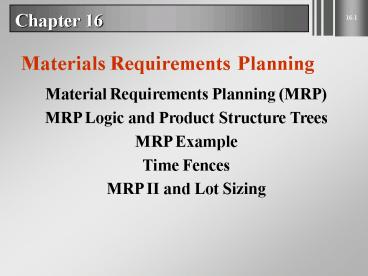Materials Requirements Planning - PowerPoint PPT Presentation
1 / 18
Title:
Materials Requirements Planning
Description:
Click to edit Master title style. 1-6. 16-6 ... Click to edit Master title style. 1-12. 16-12. Lot Sizing in MRP Programs. Lot-for-lot (L4L) ... – PowerPoint PPT presentation
Number of Views:263
Avg rating:3.0/5.0
Title: Materials Requirements Planning
1
Chapter 16
Materials Requirements Planning
Material Requirements Planning (MRP) MRP Logic
and Product Structure Trees MRP Example Time
Fences MRP II and Lot Sizing
2
Material Requirements Planning
- Materials requirements planning (MRP)
- is a technique for managing items with dependent
demand parts, components, and materials needed
to produce a product, - i.e., Raw Materials Work-in-process
- MRP provides time scheduling information
specifying when each of the materials, parts, and
components should be ordered or produced
3
Material Requirements Planning System
From Exhibit 15.6
4
Master Production Schedule (MPS)
- A schedule of planned completions of end-items
- Usually week-by-week
5
Inventory Status Record
Also called the Item Master File
- Lists
- Item number
- Quantity physically in stock
- Safety stock requirement
- Quantity allocated
- Lot size
- Lead time on orders
- Scheduled Receipts
- On order quantity timing
6
Bill of Material
- List of components quantities needed to make
product - Provides product structure (tree)
- Parents Items above given level
- Children Items below given level
- Shows low-level coding
- Lowest level in structure item occurs
- Top level is 0 next level is 1 etc.
7
The BOM Product Structure Tree
The Bill of Material can be drawn as a product
structure tree for A. Lead times are shown
below.
Product Structure Tree for Assembly A
Lead Times A 1 week B 2 weeks C 1 week D 3
weeks E 4 weeks F 1 week
8
The MRP Process Time Phasing
First, the number of units of A are scheduled
backwards to allow for their lead time. So, in
the materials requirement plan below, we have to
place an order for 50 units of A by end of the
9th week to receive them by end of week 10.
9
The MRP Process Dependent demand
Next, we need to start scheduling the components
that make up A. In the case of component B
we need 4 Bs for each A. Since we need 50 As,
that means 200 Bs. And again, we back the
schedule up for the necessary 2 weeks of lead
time.
10
The Final MRP
11
Netting-out Requirements
MRP systems also look at our inventory (on-hand
on-order) to determine how many more units are
needed (net requirements).
12
Lot Sizing in MRP Programs
- Lot-for-lot (L4L)
- Economic order quantity (EOQ)
- Least total cost (LTC)
- Least unit cost (LUC)
- Which one to use?
- The one that is least costly!
- Most firms use L4L
13
MRP Example
14
Time Fences
- Frozen
- No schedule changes allowed within this window
- Moderately Firm
- Specific changes allowed within product groups as
long as parts are available - Flexible
- Significant variation allowed as long as overall
capacity requirements remain at the same levels
15
Example of Time Fences
Exhibit 15.5
16
Closed Loop MRP
Master Production Schedule
Aggregate Plan
Material Requirements Plan
17
Manufacturing Resource Planning
Called MRP II
- Goal Plan and monitor all resources of a
manufacturing firm (closed loop) - manufacturing
- marketing
- finance
- engineering
- Simulate the manufacturing system
18
End of Chapter 16































